|
|
|
 |
 |
 |
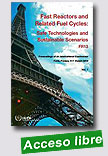 |
Fast Reactors and Related Fuel Cycles: Safe Technologies and Sustainable Scenarios
IAEA Proceedings Series, 2015, 519 p.
This publication presents the proceedings of an international conference in the field of fast reactors and related fuel cycle technologies, organized by the IAEA every four years. The conference provided a unique forum to discuss national and international fast reactor programmes, analyse new experience and advances arising from research and development programmes, and identify needs to be
|
addressed in relation to the industrial deployment of fast reactors. A CD-ROM with contributed papers accompanies the proceedings. All the scientific contributions included in these proceedings were peer reviewed by the International Scientific Programme Committee of the Conference.
Volume 1 | Volume 2 | Companion CD
Extraído de: http://www-pub.iaea.org/books/IAEABooks/10682/Fast-Reactors-and-Related-Fuel-Cycles-Safe-Technologies-and-Sustainable-Scenarios-FR13-Proceedings-of-an-International-Conference-on-Fast-Reactors-and-Related-Fuel-Cycles-Paris-France-4-7-March-2013
|
 |
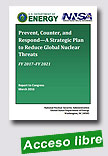 |
Prevent, Counter and Respond - A Strategic Plan to Reduce Global Nuclear Threats
National Nuclear Security Administration (DOE/NNSA), March 2016, 103 p.
The Department of Energy’s National Nuclear Security Administration (DOE/NNSA) is pleased to submit an update to Prevent, Counter, and Respond—A Strategic Plan to Reduce Global Nuclear Threats (FY 2016–FY 2020). This report, along with DOE/NNSA’s Stockpile Stewardship and Management Plan, informs our planning and program activities to ensure |
U.S. national security and advance global nuclear security.
As President Obama reaffirmed in the 2015 National Security Strategy, “No threat poses as grave a danger to our security and well-being as the potential use of nuclear weapons and materials by irresponsible states or terrorists.” Reducing this threat is one of DOE/NNSA’s enduring missions, as detailed in NNSA’s Enterprise Strategic Vision.1 Along with maintaining a safe, secure, and effective nuclear deterrent and providing naval nuclear propulsion, DOE/NNSA’s efforts to prevent, counter, and respond to the threats of nuclear proliferation and terrorism make a vital contribution to U.S. national security.
Since the initial report was published in March 2015, there have been significant changes in the nuclear and radiological threat environment. Most notably, the Joint Comprehensive Plan of Action (JCPOA, also known as the “Iran deal”) has blocked Iran’s pathways to a nuclear weapon and is ensuring that Iran’s nuclear program is exclusively peaceful. However, overall relations between the United States and the Russian Federation have worsened, and terrorist attacks in the past year in Europe and the United States have highlighted the evolving and unpredictable nature of the threat environment. This report describes these and other important developments, as well as their implications for our work.
Over the past two years, we have focused on ensuring that the programs responsible for preventing, countering, and responding to this threat are thoroughly integrated. As with our other DOE/NNSA missions pillars, our nuclear threat reduction work is enabled by the important crosscutting activities of advancing science, technology, and engineering; supporting our people and modernizing our infrastructure; and developing a management culture that promotes a safe and secure nuclear enterprise.
In February 2015, we proposed the alignment of all DOE/NNSA funding for preventing, countering, and responding to global nuclear dangers into one appropriation. To further integrate these critical activities, we transferred a number of functions from the Office of Emergency Operations to the Office of Counterterrorism and Counterproliferation in late 2015. This reorganization consolidates several related activities in order to improve collaboration and efficiency. The change also supports the Department’s objective of improving its emergency management system; the Office of Emergency Operations will take on an expanded leadership role in implementing an all-hazards enterprise-wide capability.
Extraído de: http://nnsa.energy.gov/aboutus/ourprograms/dnn/npc
|
 |
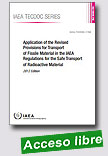 |
Application of the Revised Provisions for Transport of Fissile Material in the IAEA Regulations for the Safe Transport of Radioactive Material, 2012 Edition
IAEA TECDOC, 2015, 48 p.
The IAEA Regulations for Safe Transport of Radioactive Material, including fissile material, have been in place since 1961 and have been periodically reviewed by Member State experts and revised by the IAEA as needed to address safety concerns. The Regulations have historically provided requirements for package design, package
|
performance, and operations based, in part, on the type of radioactive material that would be included in the package. Since their introduction the Regulations have included criteria to permit the transport of fissile material in packages not requiring competent authority (CA) approval of the design for the transport of fissile material.
With the 2012 Edition of the Regulations (hereafter referred to as the 2012 Edition), the IAEA has significantly revised the approach used to allow for transport of fissile material in packages of designs other than those approved by CA for fissile material. The new approach establishes a set of provisions in a graded manner and, for each provision, establishes criteria and requirements that consistently assure criticality safety.
The 2012 Edition has four clear groups of provisions for the transport of material containing fissile nuclides: 1. Transport where the material is excluded from the definition of fissile material, 2. Transport with exception from UN “FISSILE” classification and criticality safety index (CSI) accumulation control, 3. Transport with UN “FISSILE” classification and CSI control but without CA approval as a package design for fissile material. 4. Transport in a package for which the design is approved by the CA to contain fissile material (unchanged from the 2009 Edition).
Extraído de: http://www-pub.iaea.org/MTCD/Publications/PDF/TE-1768_web.pdf
|
 |
 |
This Safety Guide provides recommendations on meeting the requirements established in the IAEA International Basic Safety Standards, for protection of the public against exposure indoors due to natural sources of radiation. Guidance is provided on the application of the requirements for justification and optimization of protection by national authorities in considering control of natural sources of radiation indoors |
such as radon and radionuclides of natural origin in materials used for the construction of dwellings, offices, industrial premises and other buildings. The Safety Guide provides recommendations and guidance to be followed by the regulatory body and by other authorities and organizations with responsibilities in relation to exposure to radiation from natural sources.
Extraído de: http://www-pub.iaea.org/books/IAEABooks/10671/Protection-of-the-Public-against-Exposure-Indoors-due-to-Radon-and-Other-Natural-Sources-of-Radiation |
 |
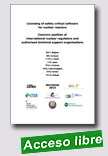 |
Licensing of Safety Critical Software for Nuclear Reactors - Common Position of International Nuclear Regulators and Authorised Technical Support Organizations - Revision 2015
Bel V, BfS, CNSC, CSN, ISTec, ONR, SSM, STUK, 2015, 167 p.
The Office for Nuclear Regulation (ONR) and six international regulators have enhanced a common position on their expectations when licensing safety critical software for nuclear reactors. This is highlighted in the latest revision of a consensus document PDF, originally published in 2000.
ONR and six other nuclear regulators from Belgium, Germany, |
Canada, Spain, Sweden and Finland have updated the document to reflect current expectations and consistent practical standards. It is also the first revision to include contributions from the US Nuclear Regulatory Commission link to external website. While the US Nuclear Regulatory Commission has not endorsed the report for direct regulatory use, it has published a separate technical document that contains the report, recognising it as a valuable reference for future improvements in its regulatory guidance.
The document is particularly relevant to new build and generic design assessments as it enables a level playing field across many countries and enables regulators to set consistent requirements. It is used routinely by the regulators concerned and is recommended to nuclear regulators and licensees all over the world.
Extraído de: http://news.onr.org.uk/2016/03/regulators-enhance-position-on-critical-software/
|
 |
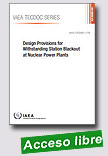
|
Design Provisions for Withstanding Station Blackout at Nuclear Power Plants
IAEA TECDOC, 2015, 104 p.
The Safety Guide entitled Design of Electrical Power Systems for Nuclear Power Plants (SSG34), provides recommendations regarding the design of electric power systems to comply with the Safety Requirements in the IAEA Safety Standards Series No. SSR-2/1. The Safety Guide Ref. makes recommendations and provides guidance on the measures that are necessary for both new and operating |
NPPs to meet the requirements in the IAEA Safety Standards Series No. SSR-2/1 relating to the functions of electrical power systems.
Section 8 of Design of Electrical Power Systems for Nuclear Power Plants (SSG34), entitled Alternate AC Power Supplies, provides basic recommendations regarding the design of electrical power systems for DEC, as applicable to SBO event.
The objective of this TECDOC is to further develop recommendations regarding the design of
electrical power systems for DEC and to provide technical guidance for the design provisions to cope with an SBO event at NPPs. This involves a discussion of current plant practices and design provisions implemented at some NPPs, as well as proposals for the improvement of current plant designs and qualification requirements to better manage an SBO event.
In 1985, the IAEA published a TECDOC Safety Aspects of Station Blackout at Nuclear Power Plants (IAEA-TECDOC-332). This original version of the TECDOC focused mainly on the safety aspects of an SBO event. Although most of the information in Safety Aspects of Station Blackout at Nuclear Power Plants is still valid, this publication is being issued to account for lessons learnt from SBO events experienced since 1985, as well as from the Fukushima Daiichi accident.
Extraído de: http://www-pub.iaea.org/MTCD/Publications/PDF/TE-1770_web.pdf
|
 |
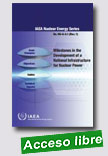 |
Milestones in the Development of a National Infrastructure for Nuclear Power
IAEA Nuclear Energy Series, 2015, 79 p.
The development and implementation of an appropriate infrastructure to support the successful introduction of nuclear power and its safe, secure, peaceful and sustainable application is an issue of central concern, especially for countries that are considering and planning their first nuclear power plant. In preparing the necessary nuclear infrastructure, there are several activities that need to be completed. These |
activities can be split into three progressive phases of development. This publication provides a description of the conditions expected to be achieved by the end of each phase to assist with the best use of resources. ‘Milestones’ refer to the conditions necessary to demonstrate that the phase has been successfully completed.
Extraído de: http://www-pub.iaea.org/books/IAEABooks/10873/Milestones-in-the-Development-of-a-National-Infrastructure-for-Nuclear-Powe
|
 |
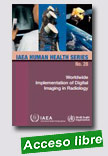 |
Worldwide Implementation of Digital Imaging in Radiology
IAEA Human Health Series, 2015, 195 p.
This publication provides a basic introduction to digital technology and digital networks as well as an overview of the issues to consider when implementing such technology in diagnostic radiology. In an area that is under rapid development, it provides a careful analysis of the principles and advice on implementation and sustainability of digital imaging and teleradiology. The transition from film to digitally based medical imaging is complex and requires knowledge
|
and planning to be successful. This comprehensive resource guide contains information on the needs and implications of a transition to digital imaging with case studies for different facilities requiring different levels of communication connectivity. It is aimed at hospital administrators and managers, radiologists and radiographers/technologists, medical physicists and clinical engineers as well as information technology staff.
Extraído de: http://www-pub.iaea.org/books/IAEABooks/10613/Worldwide-Implementation-of-Digital-Imaging-in-Radiology
|
 |
|

|
Office for Nuclear Regulation Strategic Plan: 2016-2020
Office for Nuclear Regulation (ONR - UK), March 2016, 36 p.
The plan places attention on what our stakeholders expect from us and how we intend to meet those needs. Throughout the plan, we have emphasised the importance of ONR taking an enabling approach to regulation: working together with stakeholders to influence improvements in nuclear safety and security.
The plan sets out the factors that will influence our work and the assumptions we have made about regulating the nuclear
|
sector in the next few years, as well as how we deliver the commitments we have made to the public, ministers and government, licensees, dutyholders and our staff. Information on corporate risk, resources and finance planning is also contained in the plan.
Extraído de: http://news.onr.org.uk/2016/03/onr-publishes-strategic-plan/
|
 |
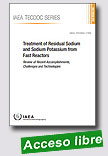 |
Treatment of Residual Sodium and Sodium Potassium from Fast Reactors: Review of Recent Accomplishments, Challenges and Technologies
IAEA TECDOC, 2015, 66 p.
The purpose of this report is to document several treatment methods for sodium and NaK contaminated waste types. These were presented in contributed papers to the International Atomic Energy Agency (IAEA) sessions at the French Nuclear Energy Society Conference at Avignon (April 2013) and developed further at a subsequent consultancy
|
meeting at IAEA (December 2013). The report will assist those involved in the decommissioning of liquid-metal cooled reactors by providing an update on current practices being used for dealing with any residual sodium or NaK remaining in the reactor following the removal of the bulk coolant and by summarizing lessons learned from recent projects.
Extraído de: http://www-pub.iaea.org/MTCD/Publications/PDF/TE-1769_web.pdf
|
 |
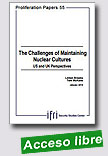 |
The Challenges of Maintaining Nuclear Cultures : US and UK perspectives
Institut Français des Relations Internationales, January 2016, 45 p.
Nuclear cultures have helped to ensure some level of coherence in policymaking and, most importantly, to maintain safe and effective deterrents. At a national level, however, each nuclear culture is confronted with significant challenges, such as generational change, decreasing levels of understanding or attention among the political and military leadership, .
|
|
 |
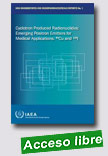 |
Cyclotron Produced Radionuclides: Emerging Positron Emitters for Medical Applications: 64Cu and 124I
IAEA Radioisotopes and Radiopharmaceuticals Reports, 2016, 63 p.
The growing number of medical cyclotrons and positron emission tomography/computed tomography (PET/CT) centres as well as the proven high clinical utility of fluorodeoxyglucose (FDG) in cancer patients has led to interest in possibilities for the use of PET tracers which are in different stages of clinical evaluation. This publication presents the outcome of an IAEA
|
coordinated research project on this topic and provides a comprehensive overview of the technologies involved in the production of copper-64 and iodine-124, techniques on preparation of targets, irradiation of targets under high beam currents, target processing, target recovery and labelling. It provides guidance to enhance copper-64 and iodine-124 production and applications. This book will appeal to scientists and technologists involved in putting cyclotron based radioisotope production into practice, as well as postgraduate students in the field.
Extraído de: http://www-pub.iaea.org/books/IAEABooks/10791/Cyclotron-Produced-Radionuclides-Emerging-Positron-Emitters-for-Medical-Applications-64C
|
| |
| |
|
|
| |
|
|
|
|
|
